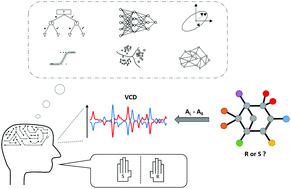Exploring machine learning methods for absolute configuration determination with vibrational circular dichroism

In this research branch, we determine the added value of supervised machine learning methods to determine the absolute configuration of compounds from their vibrational circular dichroism spectra.
- T Vermeyen, J Brence, R Van Echelpoel, R Aerts, G Acke, P Bultinck, W Herrebout, Phys. Chem. Chem. Phys., 2021,23, 19781-19789
Discovering Chemical Rules and Concepts using Explainable Deep Learning
Chemical rules and concepts are traditionally based on modest amounts of experimental and computational data. The underlying premise is that these concepts will prove more widely applicable than in the context from which they were originally derived. The question must be asked whether in this way no important concepts are missed.
In recent years, there have been important developments in the fields of ‘big data’ and ‘machine learning’, aimed at making large amounts of data manageable. One of these developments is the inception of ‘deep neural networks’. These networks can automatically detect patterns and concepts when given large amounts of data. Until recently, neural networks were essentially black boxes, in which the detected patterns remained hidden. However, thanks to advances in the field of ‘explainable artificial intelligence’, extracting these patterns in human intelligible terms has become feasible.
In this research branch, we investigate if we can discover chemical rules and concepts by only using computers: first, to calculate enormous amounts of chemical data, and second, to (re)discover and extend chemical concepts from this data using deep neural networks. By tackling incrementally more difficult problems, we aim to gradually promote the computer from a number cruncher to an insightful research assistant.


